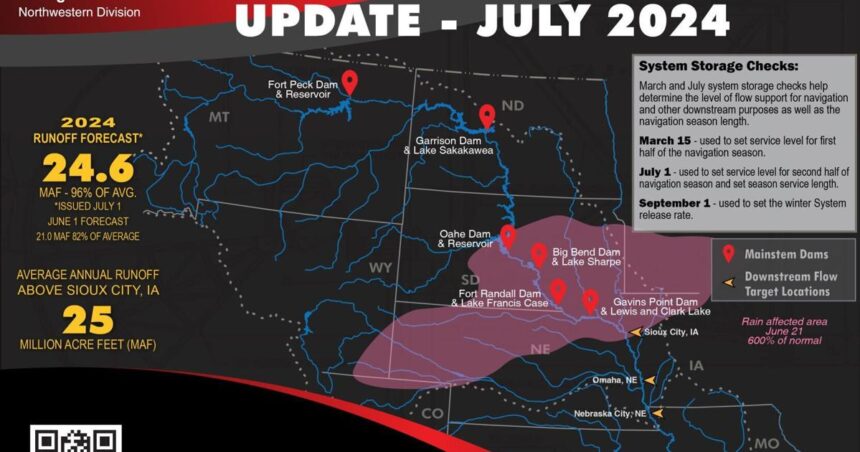A roughly 70-mile stretch of the Missouri River between Gavins Point Dam, in southeastern South Dakota, and Sioux City, Iowa, saw nearly seven times its normal June runoff this year.
Due to the heavy rainfall, the upper Missouri River Basin recorded 6.6 million acre-feet of runoff, which is 119% of average and 2.6 MAF higher than forecast, according to the U.S. Army Corps of Engineers.
The Corps is responsible for dam management along the upper Missouri River. An acre foot is the amount of water it takes to cover one acre in 1 foot of water.
While the eastern portion of the basin received excessive rainfall, other portions were drier than normal with below average runoff in the Fort Peck, Garrison and Oahe reaches. Soil moisture at the end of June is near normal in central Montana, below normal in western South Dakota, and above normal in the eastern Dakotas. Currently, 50% of the basin is experiencing abnormally dry or drought conditions.
People are also reading…
At the end of June, Fort Peck Reservoir was down 1.4 feet from May 31 at an elevation of 2,230.2 feet. The reservoir is predicted to drop another foot by the end of July.
Big storm
A strong weather system moved into the basin on June 21 producing excessive rainfall in eastern South Dakota, north-central and northeastern Nebraska and northwestern Iowa. The rainfall totals exceeded 600% of normal over the 24-hour period.
“In response to the rainfall, the releases from Fort Randall and Gavins Point dams were reduced,” said John Remus, chief of the Missouri River Basin Water Management Division, in a statement. “The lower releases were able to reduce downstream river stages, but they could not completely offset all of the flooding in the Sioux City area.”
Rainfall persisted into the following week causing sustained high inflows both into Gavins Point as well as the river downstream. Releases were reduced at Fort Randall Dam to an average of 2,000 cubic feet per second and Gavins Point to 24,000 cfs. The lowered releases in conjunction with the high inflows caused both reservoir pools to rise, reaching elevation 1360.8 feet at Fort Randall and 1209.6 feet at Gavins Point.
“During that time, some of the outflow from Gavins Point Dam was transferred from the powerhouse to the spillway, allowing us to store more water in Gavins Point Reservoir and maintain the release rate at 24,000 cfs,” Remus said.
As the inflows into Gavins Point continued to fall and the reservoir level began to decline, the spillway was closed and the release rate from the dam was stepped down to mitigate flood impacts downstream. Releases from Gavins Point Dam reached 13,000 cfs on June 28 and remain at that rate.
“As the river continues to recover from the flood event, we will continue to monitor inflows and pool elevations at Gavins Point, and throughout the Missouri River Mainstem System, and make adjustments as needed,” Remus said.
The 2024 calendar year runoff forecast for the upper Missouri River Basin above Sioux City, Iowa, is 24.6 MAF, 96% of average and 3.6 MAF higher than last month’s forecast.
Test flows
Test releases from Fort Peck Reservoir to assess the potential benefits of alternative management scenarios for pallid sturgeon began on April 26 and will be completed by Sept. 1. The test includes two higher flow periods, in late April and June, with target flows at Wolf Point.
The first peak in releases was completed in early May with peak flows of 18,000 cfs at Wolf Point. Releases were reduced to 10,000 cfs by May 10. The second peak began on June 19 and reached a peak flow of approximately 20,000 cfs on June 26. Flows are currently declining at a rate of 1,000 cfs per day and should reach an average daily flow of 8,000 cfs around July 7. The plan is to hold this flow through Sept. 1. After Sept. 1 operations at Fort Peck will return to normal.
The U.S. Army Corps of Engineers will host weekly virtual meetings during the flow test to update the public on test progress and planned operations. Information on accessing the public meetings can be found at https://www.nwd.usace.army.mil/MRWM/Public-Meetings/Meetings.
During the flow test a number of monitoring activities will be conducted to include fish monitoring, lidar and aerial photography, physical surveys, cultural resource surveys and water quality sampling. Interested parties can also provide information through a web-based application that can be found at https://hydroviz.ca/fort-peck-feedback.





